 This herbaceous perennial bulb is native to the Balkans and Middle East and has been cultivated for at least 3,000 years dating back to the Bronze age Minoans on the island of Crete where it was grown for both medicinal and ornamental purposes. It belongs to the lily family, Liliaceae, that also includes tulips and fritillaria. Plants grow 4-6′ tall and have rigid leafy stems that produce up to 20 trumpet-shaped flowers with white petals flushed with yellow at the base. The flowers appear in late spring to early summer and are 2-3″ long, outward facing, and very fragrant. The bright yellow pollen is toxic to cats. Unlike most lilies the Madonna lily produces a basal rosette of leaves in the winter that dies back in the summer. Madonna lily has been revered since the Middle Ages as a symbol of chastity, purity, and the Virgin Mary in Christian art. It is also an outstanding plant for the vase as well as for pots and the border and is especially attractive planted in groups of three. The genus name, Lilium, is from the Greek word λείριον (leiron), used to refer to a white lily perhaps the Madonna lily. The specific epithet, candidum, is the Latin word meaning white and refers to the color of the flower.
This herbaceous perennial bulb is native to the Balkans and Middle East and has been cultivated for at least 3,000 years dating back to the Bronze age Minoans on the island of Crete where it was grown for both medicinal and ornamental purposes. It belongs to the lily family, Liliaceae, that also includes tulips and fritillaria. Plants grow 4-6′ tall and have rigid leafy stems that produce up to 20 trumpet-shaped flowers with white petals flushed with yellow at the base. The flowers appear in late spring to early summer and are 2-3″ long, outward facing, and very fragrant. The bright yellow pollen is toxic to cats. Unlike most lilies the Madonna lily produces a basal rosette of leaves in the winter that dies back in the summer. Madonna lily has been revered since the Middle Ages as a symbol of chastity, purity, and the Virgin Mary in Christian art. It is also an outstanding plant for the vase as well as for pots and the border and is especially attractive planted in groups of three. The genus name, Lilium, is from the Greek word λείριον (leiron), used to refer to a white lily perhaps the Madonna lily. The specific epithet, candidum, is the Latin word meaning white and refers to the color of the flower.
Type: Herbaceous perennial bulb
Bloom: Clusters of large fragrant trumpet-shaped white flowers in late spring to early summer
Size: 4-6′ H x 1-2′ W
Light: Full sun to partial shade
Soil: Average, medium moist, well-drained; does not tolerate dry soil
Hardiness: Zones 6-9
Care: Plant 1″ deep in the fall; cut back when stems and leaves turn yellow
Pests and Diseases: Numerous diseases especially Botrytis
Propagation: Seed, separation of bulblets
Companion Plants: Armenian cranesbill, milky bellflower, columbine
Photo Credit: Wikipedia